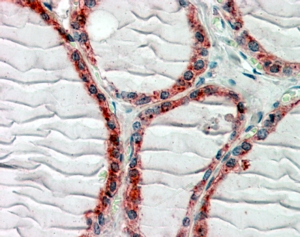Goat Anti-Restin / CLIP1 Antibody
Peptide-affinity purified goat antibody
- SPECIFICATION
- CITATIONS
- PROTOCOLS
- BACKGROUND

Application
| WB, IHC, E |
|---|---|
| Primary Accession | P30622 |
| Other Accession | NP_937883, 6249, 56430 (mouse), 65201 (rat) |
| Reactivity | Human |
| Predicted | Mouse, Rat, Pig, Dog |
| Host | Goat |
| Clonality | Polyclonal |
| Concentration | 100ug/200ul |
| Isotype | IgG |
| Calculated MW | 162246 Da |
| Gene ID | 6249 |
|---|---|
| Other Names | CAP-Gly domain-containing linker protein 1, Cytoplasmic linker protein 1, Cytoplasmic linker protein 170 alpha-2, CLIP-170, Reed-Sternberg intermediate filament-associated protein, Restin, CLIP1, CYLN1, RSN |
| Format | 0.5 mg IgG/ml in Tris saline (20mM Tris pH7.3, 150mM NaCl), 0.02% sodium azide, with 0.5% bovine serum albumin |
| Storage | Maintain refrigerated at 2-8°C for up to 6 months. For long term storage store at -20°C in small aliquots to prevent freeze-thaw cycles. |
| Precautions | Goat Anti-Restin / CLIP1 Antibody is for research use only and not for use in diagnostic or therapeutic procedures. |
| Name | CLIP1 |
|---|---|
| Synonyms | CYLN1, RSN |
| Function | Binds to the plus end of microtubules and regulates the dynamics of the microtubule cytoskeleton. Promotes microtubule growth and microtubule bundling. Links cytoplasmic vesicles to microtubules and thereby plays an important role in intracellular vesicle trafficking. Plays a role macropinocytosis and endosome trafficking. |
| Cellular Location | Cytoplasm. Cytoplasm, cytoskeleton. Cytoplasmic vesicle membrane; Peripheral membrane protein; Cytoplasmic side. Cell projection, ruffle. Note=Localizes to microtubule plus ends (PubMed:17889670, PubMed:21646404). Localizes preferentially to the ends of tyrosinated microtubules (By similarity). Accumulates in plasma membrane regions with ruffling and protrusions. Associates with the membranes of intermediate macropinocytic vesicles (PubMed:12433698) {ECO:0000250|UniProtKB:Q922J3, ECO:0000269|PubMed:12433698, ECO:0000269|PubMed:17889670, ECO:0000269|PubMed:21646404} |
| Tissue Location | Detected in dendritic cells (at protein level). Highly expressed in the Reed-Sternberg cells of Hodgkin disease |

Thousands of laboratories across the world have published research that depended on the performance of antibodies from Abcepta to advance their research. Check out links to articles that cite our products in major peer-reviewed journals, organized by research category.
info@abcepta.com, and receive a free "I Love Antibodies" mug.
Provided below are standard protocols that you may find useful for product applications.
References
Cdc2-mediated phosphorylation of CLIP-170 is essential for its inhibition of centrosome reduplication. Yang X, et al. J Biol Chem, 2009 Oct 16. PMID 19687009.
Microtubule plus-end tracking by CLIP-170 requires EB1. Dixit R, et al. Proc Natl Acad Sci U S A, 2009 Jan 13. PMID 19126680.
Dynein, Lis1 and CLIP-170 counteract Eg5-dependent centrosome separation during bipolar spindle assembly. Tanenbaum ME, et al. EMBO J, 2008 Dec 17. PMID 19020519.
The membrane-tubulating potential of amphiphysin 2/BIN1 is dependent on the microtubule-binding cytoplasmic linker protein 170 (CLIP-170). Meunier B, et al. Eur J Cell Biol, 2009 Feb. PMID 19004523.
Lamellar bodies of human epidermis: proteomics characterization by high throughput mass spectrometry and possible involvement of CLIP-170 in their trafficking/secretion. Raymond AA, et al. Mol Cell Proteomics, 2008 Nov. PMID 18622020.
If you have used an Abcepta product and would like to share how it has performed, please click on the "Submit Review" button and provide the requested information. Our staff will examine and post your review and contact you if needed.
If you have any additional inquiries please email technical services at tech@abcepta.com.













 Foundational characteristics of cancer include proliferation, angiogenesis, migration, evasion of apoptosis, and cellular immortality. Find key markers for these cellular processes and antibodies to detect them.
Foundational characteristics of cancer include proliferation, angiogenesis, migration, evasion of apoptosis, and cellular immortality. Find key markers for these cellular processes and antibodies to detect them. The SUMOplot™ Analysis Program predicts and scores sumoylation sites in your protein. SUMOylation is a post-translational modification involved in various cellular processes, such as nuclear-cytosolic transport, transcriptional regulation, apoptosis, protein stability, response to stress, and progression through the cell cycle.
The SUMOplot™ Analysis Program predicts and scores sumoylation sites in your protein. SUMOylation is a post-translational modification involved in various cellular processes, such as nuclear-cytosolic transport, transcriptional regulation, apoptosis, protein stability, response to stress, and progression through the cell cycle. The Autophagy Receptor Motif Plotter predicts and scores autophagy receptor binding sites in your protein. Identifying proteins connected to this pathway is critical to understanding the role of autophagy in physiological as well as pathological processes such as development, differentiation, neurodegenerative diseases, stress, infection, and cancer.
The Autophagy Receptor Motif Plotter predicts and scores autophagy receptor binding sites in your protein. Identifying proteins connected to this pathway is critical to understanding the role of autophagy in physiological as well as pathological processes such as development, differentiation, neurodegenerative diseases, stress, infection, and cancer.



